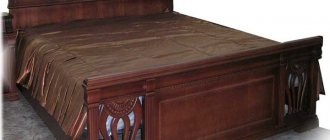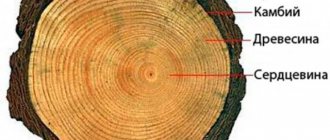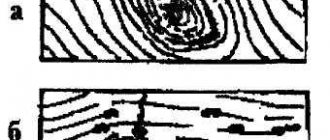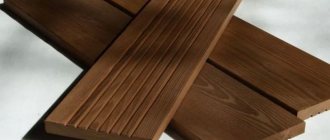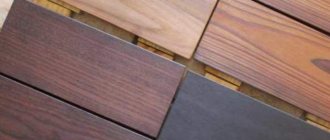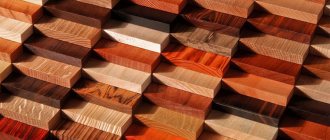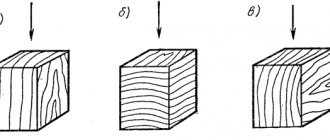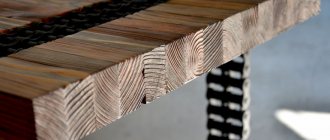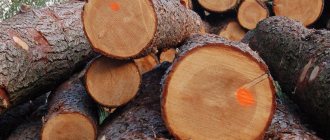Pear. Properties of wood
Pear is a kernel-free, scatter-vascular breed.
Pear wood is hard, durable, and wear-resistant. Wood of wild pear varieties according to the physical characteristics of cultivated, “domesticated” varieties.
Strength of pears using the example of the Pear Caucasian variety. Tensile strength across the fibers at humidity, 12% - 7.06/4.53 MPa, at humidity more than 30% -3.82/2.35 MPa. Has high wear resistance. Pear wood has a smooth, soft, poor texture. Pear wood is difficult to process. Requires careful drying; if dried quickly, it may warp and crack.
Pear wood has high impact strength, the indicators are close to those of oak and ash. The fasteners hold very well, at the level of the birch.
The color of the wood depends on the age of the tree. Young pears have lighter wood, older pears have darker wood. Pear wood has a warm shade, from yellowish-pink (in a young tree) to dark red (in an old tree)
Pear wood is used to produce various types of veneer, drawing tools, foundry molds, parquet, furniture and interior trim for luxury cars. The cost of wood is relatively low. Therefore, along with high strength, hardness, and wear resistance, it is in fairly high demand among builders.
Pear wood is easily polished and takes well to processing agents, varnishes and paints. Sticks well.
Use of pear wood
Thoroughly dried, varnished parts perfectly retain their size and shape in dry rooms. And, nevertheless, it is still better not to use it for the exterior decoration of buildings, structures and damp rooms. Pear wood behaves very well in joints with screws and glue. For finishing pear wood products, paints and varnishes based on organic solvents and water-soluble varnishes, stains and paints are equally suitable.
After direct steaming, pear wood becomes lighter and acquires a pinkish-brown color. Pear is indistinguishable and easily finished to look like ebony (black) wood. Such wood is often used for interior decoration in various rooms. The properties of such wood make it indispensable for creating parquet.
Interior details of wall panels, their individual parts, molded products, elements of stairs and the like, in combination with details from other types of wood, for example, plum or apple tree, give a feeling of special comfort and coziness. In fact, pear harmonizes perfectly in the interior with most existing materials, for example, bronze, brass, wallpaper, steel.
In the process of creating musical instruments, such wood is, in fact, a kind of substitute for ebony. Small pear carvings are soaked in a special aqueous solution of tannide, boiled in a decoction of ink nuts or oak bark, dried, kept in a special aqueous solution of iron sulfate, and the product quickly darkens. Parts of musical instruments are deeply dyed with black aniline dye nigrosine.
However, due to the fact that the natural shade of wood is beautiful, all artistic works made from it are rarely painted. You just need to wipe their surface with wax mastic or linseed oil so that it acquires a nice dark brown shade and a pleasant light shine.
Pear. Beneficial features
The pear contains the following vitamins and microelements that are beneficial for the human body:
Vitamins – A, B1, B2, B3, B5, B6, B9, C, E, P, PP, as well as tannins
The pear contains an antibiotic that kills pathogens that cause inflammation of the kidneys and bladder. Fresh pear and drinks made from fresh and dried pear are often included in the diet of people with diabetes and obesity. This is due to the fact that pears contain more fructose, which is useful for pancreatic dysfunction.
A decoction of dried pear will help with bronchitis and other lung diseases. Pear juice helps strengthen blood vessels and capillaries due to the vitamin P content in the fruit. Pear juice is a good diuretic.
Pear is used to treat prostatitis. Long-term use of pear compote leads to healing.
Health to you!)
Subscribe to our Yandex.Zen channel
Pear
Common pear or wild pear
(Pyrus communis) is one of the species of the genus Pear, distributed in the territory from Eastern Europe to Western Asia.
It is on the basis of this species that most pear varieties grown in temperate regions of Europe, North America and Australia are bred (in Western Asia, two other types of pear are more used - Pear-leaved pear
(
Pyrus pyrifolia
) and
Bretschneider pear
(
Pyrus bretschneideri
).
Botanical description
Botanical illustration from the book by O. W. Thome Flora von Deutschland, Österreich und der Schweiz, 1885
Tree 6–9 m high (sometimes up to 20 m) and trunk diameter 15–30 cm, sometimes a large shrub. The shoots are prickly. The leaves are oblong-rounded, short-pointed, leathery, on long petioles, turning black when dry.
Flowers are collected 6–12 in corymbose inflorescences, formed from fruit buds formed in the previous year. The perianth is double, five-membered. The corolla is up to 3.5 cm in diameter, snow-white, sometimes pinkish. There are many stamens, they have a purple-pinkish color. Nectar-bearing tissue is located on the open receptacle. In both wild and cultivated forms, flowering is abundant and begins with the appearance of leaves, in May, somewhat earlier than in the apple tree. Trees in plantations bloom for 14–16 days, individual flowers up to 5 days.
The fruits are pear-shaped or round, ripen in August – September.
Varieties
- Pyrus communis L. subsp. communis
- Pyrus communis L. subsp. caucasica [syn. Pyrus caucasica Fed. – Caucasian pear]basionym
- Pyrus communis L. subsp. pyraster [syn. Pyrus pyraster (L.) Burgsd. – Forest pear]
Fruit
The fruits contain 6–13% sugars (mostly monosaccharides), 0.12–0.19% malic, citric and ascorbic acids, up to 4% pectins and tannins, and some carotene. The seeds contain 12–21% fatty oil.
The fruits of the common pear are used for compotes and the preparation of essences from which fruit drinks are made; they are suitable for distilling wine and vinegar, and kvass is made from them. In the Caucasus, dried fruits are ground and added to flour, from which flatbreads are baked. The best quality pear fruits can be used for jam, marmalade, and marshmallows. Roasted seeds in the Caucasus were used to prepare a coffee surrogate. Fresh pears, taken in small quantities, regulate digestion and are perfectly absorbed by the human body.
Dried fruits have long been used in folk medicine. A decoction of dried pears quenches thirst during febrile diseases, has an analgesic, antiseptic and diuretic effect, which relieves diarrhea. Boiled and baked pears are used for severe coughing, choking and pulmonary tuberculosis.
Pears are of great importance in dietary nutrition, especially for diabetics. Due to the presence of stony cells that give grain to the fruit, consuming pear fruit pulp in any form (only juice or compote without pulp is permissible) is undesirable for certain diseases of the gastrointestinal tract, in particular pancreatitis.
Pear flowers provide bees with a very valuable spring supply of nectar and pollen, but in terms of honey production, the pear is inferior to the cherry, plum and apple tree. The honey productivity of pears is about 20 kg of honey per 1 hectare of plantings. The nectar collected by bees from pears contains little sugar. According to other data, flowers secrete up to 1 mg of sugar in nectar per day and produce a lot of pollen, and the honey productivity of plantings is 10–25 kg/ha.
The common pear is widely used in steppe afforestation, field protection and roadside plantings.
Bark used to dye handmade carpets and fabrics brown.
The fruits and, to a lesser extent, leafy branches are food for domestic and wild animals.
Wood
The heartwood is pale pink or light reddish brown. The sapwood is slightly paler, but usually indistinguishable from the heartwood. The pear is sometimes steamed to deepen the pink color. Pear is also sometimes stained black and used as a substitute for ebony. The fibers are usually straight, with a very fine, uniform texture. The fibers at the end are diffusely porous and small, without a specific arrangement. The core sometimes contains red-brown mineral deposits (gum).
Pear is used for the production of lumber, architectural carpentry, marquetry, inlay, wood carving, musical instruments, and furniture.
What wand does Hermione have?
Hermione Granger's wand was 10 inches long, made from vine and possessed a dragon heartstring core
. The wand was made by Garrick Ollivander shortly before Hermione entered Hogwarts School of Witchcraft and Wizardry.
What wand does Harry Potter have? Harry Potter's wand was 11 inches long, made of holly, and had a phoenix feather core.
. Garrick Ollivander described it as an unusual combination of wand core and wood. The feather was given by Fawkes, Albus Dumbledore's phoenix.
What is a phoenix feather?
Phoenix feathers were feathers dropped by phoenixes
, are mainly collected and used to make sticks. The phoenix feather was one of the three main basic types. It was one of the rarest cores with the largest power range, and loyalty was hard to win.
What was Ron's wand made of? Ronald Weasley's second wand was 14 inches long and made of willow and had a unicorn hair core
. The wand was made by Garrick Ollivander. This wand seemed to suit Ron better than his first wand, which he had inherited from his older brother Charlie.
What is Ginny's wand made of?
Ginny Weasley's wand is made from yew wood of unknown length and core material.
. The wand was made by Garrick Ollivander shortly before Ginny began her training at Hogwarts School of Witchcraft and Wizardry. The Yew Wand is suitable for a person who is a fierce defender of others.
Which wand killed Voldemort? The curse that killed Lord Voldemort came from the Elder Wand
. Because Voldemort thought Snape was the master, Voldemort killed him. Draco, however, was the true master as he disarmed Dumbledore and then Harry disarmed Draco.
Don't forget to share this post

